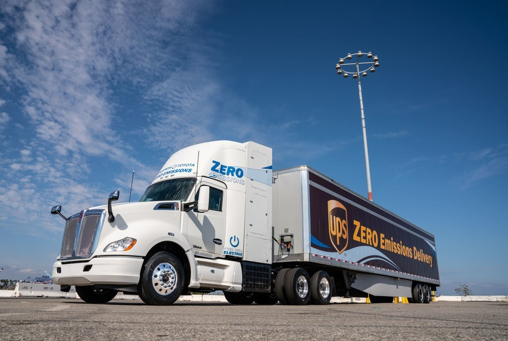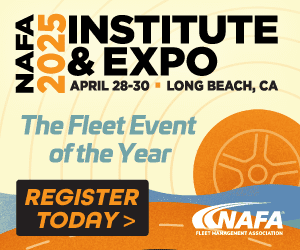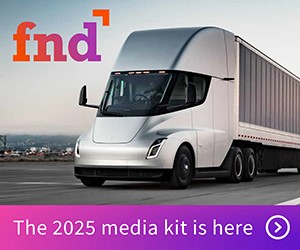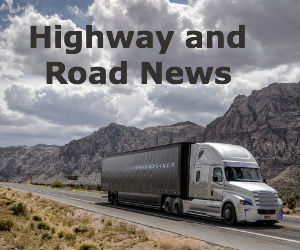The Future Of Zero-Emission Trucking Takes Another Leap Forward

Zero-and-Near-Zero-Emission Freight Facilities Project Stakeholders Reveal ‘Shore-to-Store’ Project with Unveiling of Fuel Cell Electric Heavy-Duty Truck
Toyota, Kenworth, the Port of Los Angeles and the California Air Resources Board (CARB) took the next great leap towards the future of zero-emission trucking, unveiling the first of Toyota and Kenworth’s jointly developed fuel cell electric heavy-duty trucks (FCET). The unveiling was before a crowd of media, government officials and industry and community leaders during a special event held at the Port of Los Angeles.
The new generation zero-emission truck expands on the capabilities of Toyota’s first two Project Portal Proof of Concept trucks through enhanced capability, packaging, and performance; offering an estimated range of more than 300 miles per fill, twice that of a typical drayage truck’s average daily duty cycle. Toyota and Kenworth will deploy a total of 10 trucks as part of the Zero-and-Near-Zero-Emission Freight Facilities Project (ZANZEFF), hauling cargo received at the Ports of Los Angeles and Long Beach, throughout the LA Basin.
“Toyota is committed to fuel cell electric technology as a powertrain for the future because it’s a clean, scalable platform that can meet a broad range of mobility needs with zero emissions,” said Bob Carter, Executive Vice President for Automotive Operations Toyota. “The ZANZEFF collaboration and the innovative ‘Shore-to-Store’ project allow us to move Heavy-Duty Truck Fuel Cell Electric technology towards commercialization.”
CARB has awarded $41 million dollars to the Port of Los Angeles for the ZANZEFF project as part of California Climate Investments, a California initiative that puts billions of cap-and-trade dollars to work reducing greenhouse gas emissions, strengthening the economy and improving public health and the environment, particularly in disadvantaged communities.
“This substantial climate investment by the state, matched by the project partners, will help speed up the number of zero-emission trucks in the California communities and neighborhoods where they are needed the most,” said CARB Chair, Mary D. Nichols. “It will provide a real world at-work demonstration of innovative heavy-duty fuel cell electric technologies. The project offers a commercial solution to move cargo and freight around the state using zero-emission trucks and equipment that protect air quality and cut climate-changing emissions.”
Since operations began in April 2017, the Project Portal “Alpha” and “Beta” Proof of Concept Class 8 trucks have logged more than 14,000 miles of testing and real-world drayage operations in and around the ports of Los Angeles and Long Beach while emitting nothing but water vapor. The first Kenworth/Toyota FCET under the ZANZEFF project will begin drayage operations in the fourth quarter, increasing the ports’ zero-emission trucking capacity and further reducing the environmental impact of drayage operations.
Expanding operations
The latest FCET utilizes the
Kenworth T680 Class 8 model combined with Toyota’s fuel cell electric
technology and is part of the ZANZEFF project. Pioneered by the Port
of Los Angeles with leading support from Toyota, Kenworth, and Shell,
the trailblazing endeavor provides a large-scale “Shore-to-Store”
plan and a hydrogen fuel cell electric technology framework for freight
facilities to structure operations for future goods movement. The
initiative will help reduce emissions by over 500 tons of greenhouse gas and
0.72 weighted tons of NOx, ROG and PM10.
“The collaboration between the Port of Los Angeles, Kenworth, Toyota and Shell is providing an excellent opportunity to demonstrate the viability of fuel cell electric technology in both drayage service and regional haul commercial vehicle applications operating in Southern California,” said Mike Dozier, general manager of Kenworth Truck Company and PACCAR vice president. “The performance of the 10 Kenworth Class 8 trucks being developed under this program, the first of which debuted today, is targeted to meet or exceed that of a diesel-powered truck, while producing water as the only emissions byproduct.”
The Port of Los Angeles, a global maritime leader with respect to zero-emission and near-zero-emission technology testing and adoption, will develop the project in several phases, ultimately encompassing initiatives in Southern California, the Central Coast Area, and Merced County. The initial phase is designed to kick-start the leap to a new class of goods movement vehicles, while reducing emissions in designated disadvantaged communities.
“CARB’s $41 million grant was instrumental in launching this project and putting this innovative technology into our rigorous environment,” said Port of Los Angeles Executive Director Gene Seroka. “We’re extremely proud of our role as a leading test lab for emerging green technology, helping to pave the way for next-generation, zero-emission technology.”
The project phases will include:
- Ten new zero-emissions Kenworth/Toyota FCET developed through a collaboration between Kenworth and Toyota to move cargo from the Los Angeles and Long Beach ports throughout the Los Angeles area, the Inland Empire, the Port of Hueneme, and eventually to Merced. The trucks will be operated by Toyota Logistics Services (4), United Parcel Services (3), Total Transportation Services Inc. (2), and Southern Counties Express (1). “It’s an honor for UPS to be collaborating with Toyota, Shell and Kenworth on such a trail-blazing project,” said Carlton Rose, president of global fleet maintenance and engineering for UPS. “As a company always looking for the next innovative technology to better serve our customers, UPS was very pleased to be selected as a demonstrating partner for the hydrogen fuel cell electric semi project. With more than 10,000 alternative fuel and advanced technology vehicles in our fleet today, UPS has a long history of pioneering and evaluating technologies that aid us in decreasing our environmental footprint.”
- Two new large-capacity heavy-duty hydrogen fueling stations will be developed by Shell in Wilmington and Ontario, California. The two new stations will join three additional stations located at Toyota’s Long Beach Logistics Services and Gardena R&D facilities to form an integrated, five station heavy-duty hydrogen fueling network for the Los Angeles basin. Together, these stations will provide multiple sources of hydrogen throughout the region, including over one ton of 100% renewable hydrogen per day at the Toyota Logistics Services station to be operated by Shell, and important research and development advances at a pair of stations operated by Air Liquide, all enabling zero-emissions freight transport.
- Expanded use of zero-emissions technology in cargo terminal and warehouse environments, including the first two zero-emissions yard tractors to be operated at the Port of Hueneme, as well as the expanded use of zero-emissions forklifts at Toyota’s port warehouse.
A Drop of h2 in the Bucket
Over 16,000 trucks serve the Los
Angeles and Long Beach port complexes, North America’s largest
trade gateway for containerized cargo. That number is estimated to grow to
32,000 by 2030. Currently, more than 43,000 drayage trucks are in operation at
ports across the United States.
Category: Engines & Drivetrains, Featured, Fuel & Oil, General Update, Green, News










